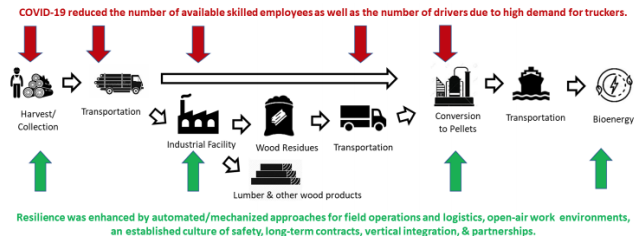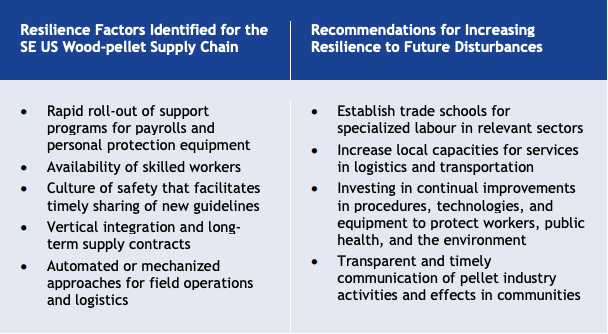Supply chain resilience during a pandemic – Lessons from the Southeast United States wood-pellet supply chain response to COVID-19
Unexpected disturbances and disruptions are on the rise with climate change. This paper provides a rare, in-depth analysis of the financial sustainability and resilience of a bioenergy supply chain during the COVID pandemic, offering valuable insights for improving resilience of this and other supply chains. Wood-based pellets shipped from the Southeast US (SE US) displace coal for generation of heat and power in Europe. Economic and employment data are used to review the effects of COVID-19 and to better understand how the supply chain adapted during the pandemic. Factors that supported and limited resilience are identified. Linkages with timber and construction industries create demand for wood products, generate more residue for pellets, and are among drivers of post-COVID economic recovery. The findings provide guidance for developing circular and more sustainable bio-economies.
The work was supported by IEA Bioenergy Task 43 (biomass supply). The full paper ‘Resilience lessons from the southeast US woody pellet supply chain response to the COVID-19 pandemic’, authored by K.L. Kline, V. Dale, and E. Rose, is published in Open Access in the Journal Frontiers in Forests & Global Change: https://doi.org/10.3389/ffgc.2021.674138

Figure 1: Supply chain for wood-based pellets from the SE US shipped overseas for bioenergy illustrating steps where COVID-19 had impacts (solid red arrows) and examples of mitigating conditions that supported resilience (green arrows).
Effects of COVID-19 on the SE US wood-pellet supply chain
Effects of the pandemic on the US economy were extensive, disrupting employment, financial markets, shipping, and other industries. To estimate effects on the SE pellet supply chain, trends and operations prior to February 2020 were compared to data following the COVID outbreak. Economic, social, and environmental conditions related to supply chain production, transport, and use of woody bioenergy are considered (Fig 2). COVID affected skilled workers, transportation, and industries along the supply chain. While overall US employment fell drastically, employment in the SE pellet industry continued to grow.

Figure 2. Changes over time in the quantity (tons) of densified biomass (A) exported from the US and (B) produced in the SE US; and (C) average price per ton of densified biomass, and (D) number of full-time equivalent employees (FTEs) employed in the production of densified biomass in the SE US. Data from US Energy Information Administration. A national emergency was declared in the US on March 13, 2020 (as indicated by the red line and shaded area).
Conclusions
Although many supply chains were severely disrupted, the SE US pellet supply chain displayed remarkable resilience during the COVID pandemic and demonstrates how a wood-based bioenergy supply chain can be maintained despite a major global economic disruption. The case study also illustrates opportunities for biomass to be an integral part of post-pandemic recovery plans. Building trust through effective participation represents a challenge for enhancing resilience of this and other wood-based supply chains.
Summary available at: https://task43.ieabioenergy.com/wp-content/uploads/sites/11/2021/08/2021-Resilience-lessons-SE-woody-pellet-supply-chain_IEA-Bioenergy-summary-Aug2021.pdf
The conclusions were also presented in the IEA Bioenergy webinar of 3 June 2021: https://www.ieabioenergy.com/wp-content/uploads/2021/06/Kline-SE-US-pellet-resilience-case-for-IEA-Bioenergy-Webinar-03-June-2021-final.pdf




